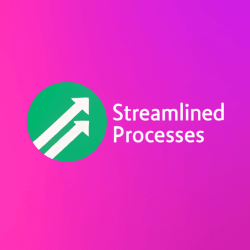For Operational Efficiency Strategies, see our main page here.
What Are Operational Efficiency Strategies?
Operational Efficiency Strategies are focused efforts to improve how a business uses its time, money, and resources. These strategies aim to reduce waste, increase output, streamline workflows, and boost profits. In other words, they’re the practical measures and systems your organization brings in to do more with less.
Companies across industries—from healthcare to manufacturing—rely on these strategies to stay competitive and deliver value. For example, Toyota’s lean manufacturing system is a classic case. It helped cut inventory costs and speed up production. As a result, Toyota became a global leader in efficiency and innovation.
Why Operational Efficiency Is Mission-Critical
In today’s economy, organizations face rising costs and customer expectations. Therefore, maximizing productivity while reducing overhead is no longer optional. Most importantly, efficient operations often lead to higher-quality products, better customer service, and faster time-to-market.
Consider a logistics company. If delivery routes aren’t optimized, the business pays more for fuel, labor, and time. However, by implementing route analysis software and real-time GPS updates, the company can deliver faster and slash costs. Consequently, customers are happier and operational budgets remain in check.
Core Operational Efficiency Strategies
- Lean Processes: Eliminate waste and non-value-added activities across the production or service cycle.
- Process Automation: Use technology to run repetitive tasks like invoicing, scheduling, or reporting without human input.
- Performance Metrics: Track key performance indicators (KPIs) to measure efficiency, identify issues, and act quickly.
- Standardization: Ensure consistency and quality by creating repeatable workflows and documentation.
- Continuous Improvement (Kaizen): Empower employees to constantly suggest, test, and apply small improvements.
These strategies can work together or be applied one at a time, depending on an organization’s scale and industry. For example, a small law firm may begin by automating appointment reminders, while a large retail chain implements a full lean transformation.
Technology’s Role in Operational Efficiency Strategies
Technology is central to most Operational Efficiency Strategies. In recent years, AI-powered tools, cloud software, and the Internet of Things (IoT) have created new ways to improve accuracy, speed, and scale.
For instance, AI chatbots manage customer inquiries 24/7. Moreover, tools like Trello or Asana help teams track tasks and automate hand-offs. In manufacturing, IoT sensors predict machine failure before it happens, reducing downtime.
However, implementing tech without changing behavior can lead to failure. So leaders must align tech decisions with strategic goals and employee training. A new tool only works when people know how and why to use it effectively.
Real-World Applications That Deliver Results
Across industries, organizations are seeing powerful results from smart efficiency initiatives. Let’s look at a few standout examples:
- Healthcare: Hospitals use predictive analytics to reduce patient wait times and optimize staffing. As a result, patient satisfaction and outcomes improve.
- Retail: Companies like Walmart use real-time inventory management to avoid stockouts and reduce waste. Their logistics systems are models of efficiency.
- Software Development: Agile and DevOps approaches enable faster delivery of code with fewer bugs. Similarly, continuous integration tools help automate testing and deployment.
Each of these examples shows how simple process changes can scale into major returns. Therefore, even small companies should examine their daily habits to identify inefficiencies.
How to Start With Operational Efficiency Strategies
Starting doesn’t require a huge investment. First, map your current processes and identify bottlenecks. Then analyze which steps delay progress or lead to repeated errors.
Secondly, choose a simple area to improve. It could be how teams handle approvals, respond to emails, or prepare invoices. Apply one strategy—such as automation or standardization—and track the results.
Use feedback loops to refine the approach. In addition, engage employees in identifying inefficiencies. After that, slowly expand improvements across departments. This step-by-step expansion builds trust and reduces shock from larger changes.
Common Challenges and How to Solve Them
Despite their benefits, these strategies can fail without careful execution. Typical missteps include:
- Overcomplicating tools: Tech should simplify work, not create more confusion.
- Ignoring employee input: Frontline teams often know where inefficiencies hide.
- Poor communication: If leaders don’t share the vision, teams won’t buy in.
- Lack of follow-through: Improvements must be maintained, not just launched.
To avoid these traps, prioritize clarity, training, and realistic timelines. Also, reward early wins to build momentum and keep morale high.
Trends Shaping the Future of Operational Efficiency Strategies
Looking ahead, several trends are reshaping how businesses approach efficiency:
- AI and Machine Learning: These technologies can identify patterns and suggest improvements automatically.
- Remote Work Optimization: Tools for asynchronous communication and digital collaboration are essential today.
- Sustainability: Efficiency now includes reducing environmental impact, such as shrinking your carbon footprint.
Consequently, organizations must blend automation with human-centered design. You need systems that improve results without reducing employee satisfaction or wellbeing.
FAQ: Operational Efficiency Strategies
- Q: How long does it take to see results?
A: Some improvements, like automation, show results in weeks. Others, like cultural change, take months. - Q: Do these strategies work for small businesses?
A: Absolutely. In fact, small companies often adapt more quickly due to less red tape. - Q: What key metrics should I track?
A: Track cycle time, cost per task, defect rates, and employee satisfaction. Choose KPIs that align with business goals.
Final Thoughts on Efficiency Success
In conclusion, businesses thrive when they work smarter—not just harder. Operational Efficiency Strategies make that possible by removing waste and focusing on what drives value.
Whether you’re launching a startup or running a multi-location enterprise, the principles of improved efficiency apply. Start small, involve your team, and use data to guide decisions. The payoff becomes clear in performance, customer satisfaction, and long-term savings.
This article was created with the assistance of AI tools and reviewed by our team at Streamlined Processes LLC to ensure accuracy and relevance.
Follow us on Facebook here.

